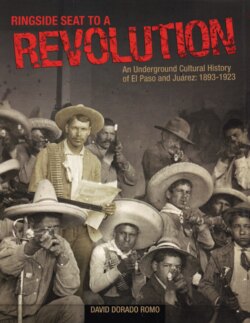Читать книгу Ringside Seat to a Revolution - David Dorado Romo - Страница 23
На сайте Литреса книга снята с продажи.
Оглавление18
But I guess I shouldn’t be too irritated by Metz’ take on things. Historians are like the
blind men who touched different parts of the elephant and thought it was either a wall,
a snake, a tree trunk or a rope, depending on what they touched. We all have our biases
and our limited viewpoints. It all depends on where we stand. Microhistorians, I think, are
just a little more honest about it. We tend to believe that there is no such thing as a defin-
itive History—only a series of microhistories.
Because I can’t fit the whole elephant into this book, all I can do is share with you
the part that I can perceive.
EL PASO PROBABLY had more Spanish-language newspapers
per capita during the turn of the century than any other city in the
United States. Between 1890 and 1925, there were more than 40
Spanish-language newspapers published in El Paso. They provided
a counternarrative of the border not found in the mainstream press
on either side of the line. These periodicals printed not only news
and political manifestoes but serial novels, poetry, essays and other
literary works as well. The cultural milieu created by a large inflow
of political refugees and exiles—which included some of Mexico’s
best journalists and writers—set the stage for a renaissance of
Spanish-language journalism and literature never before seen in the
history of the border. The first novel of the revolution, Los de Abajo,
was published in serial form in 1915 in the Spanish-language daily,
El Paso del Norte. Mariano Azuela, a former Villista doctor, wrote it
while he lived in the Segundo Barrio.
These Spanish-language newspapers, even when they didn’t
deal with politics or literature, served as a voice for the ethnic
Mexican community in El Paso that usually didn’t see itself reflected
in the Anglo press. They carried ads for Mexican-run businesses on
both sides of the line—for grocery stores owned by Mexican mer-
chants or pharmacies that sold natural medicinal herbs from
Mexico. They published classifieds seeking musicians for a
Mexican orchestra. The readers could be updated on the latest gossip about the man who
paid 200 pesos ($100 in U.S. dollars) for a kiss as part of a neighborhood fundraiser. They
could also tear out a ballot to elect the local Mexican American beauty queen.
Yet politics was indeed most of these publications’ bread and butter. Because they
were published on the American side of the border, the Spanish-language press could be
aggressively anti-Díaz. Many of them were openly revolutionary. Victor L. Ochoa, the first
El Pasoan to lead a rebellion against the government of Porfirio Díaz in 1893, was the edi-
tor of El Hispano Americano.
In 1896, Teresita Urrea was listed as the coeditor with Lauro
Aguirre of El Independiente. She had moved to El Paso that year and was already called
the “Mexican Joan of Arc” because of the various uprisings her name had inspired
throughout northern Mexico. In 1907, Aguirre’s press also printed La Voz de la Mujer. It
was a fiery, aggressive weekly, which called itself “El Semanario de Combate,” written and
edited by women who had no qualms about denouncing their political enemies as
“eunuchs” and “castrados” (castrated men).5 Those epithets were particularly insulting to
Spanish-language newspapers
in El Paso carried ads that
catered to the needs of the
ethnic Mexican community
on the border. This turn-of-the-
century advertisement in
Lauro Aguirre’s Reforma
Social lists both medicinal
herbs from Mexico and
French drugs that were on
sale at a Mexican-owned
pharmacy on Stanton Street.
(El Paso Public Library.)
5
La Voz de la Mujer, July 28, 1907, Bancroft Library, UC Berkeley.
